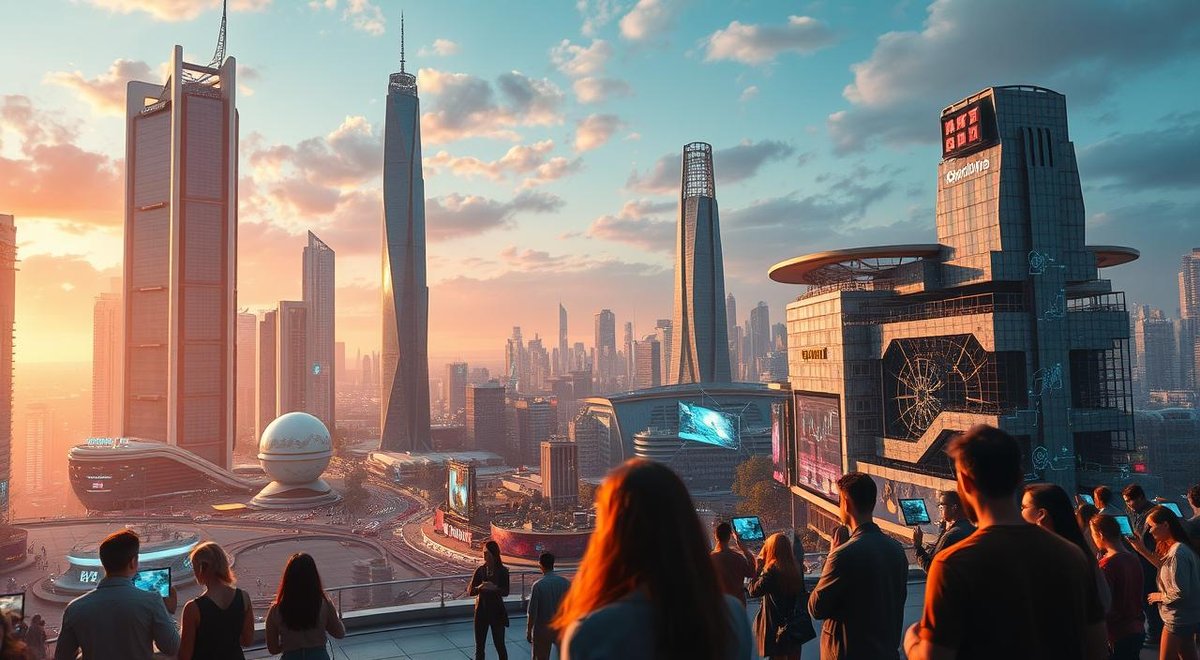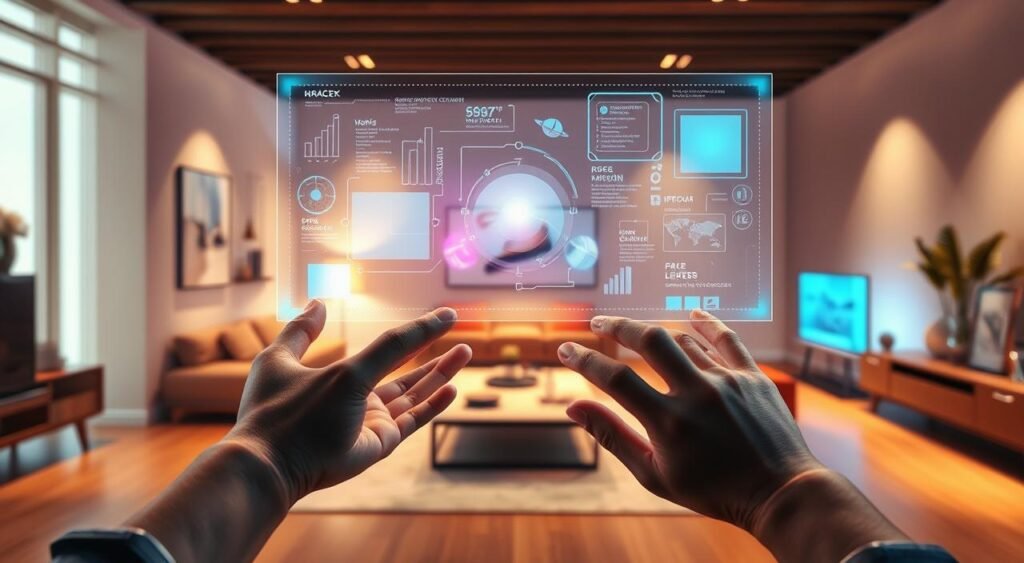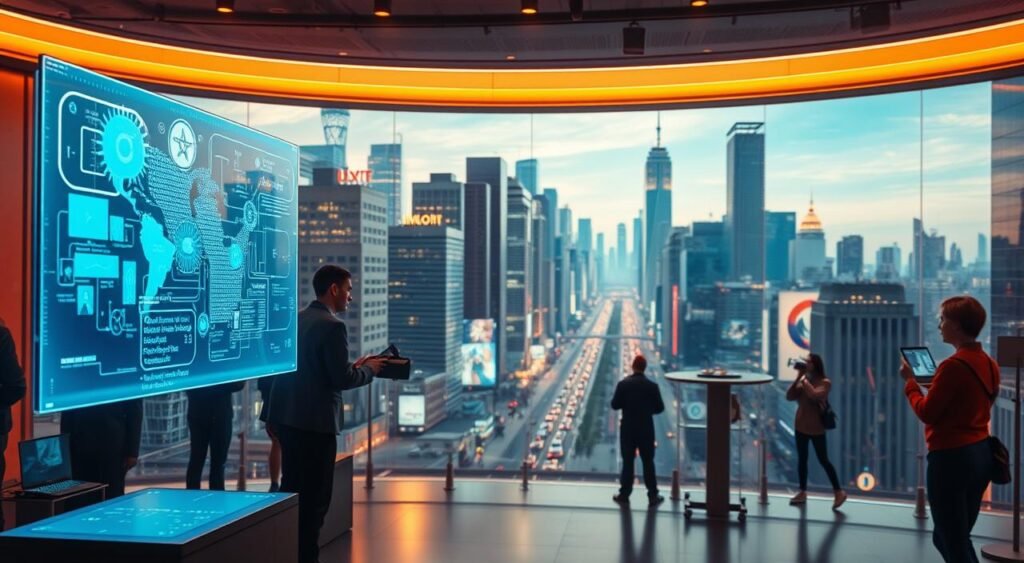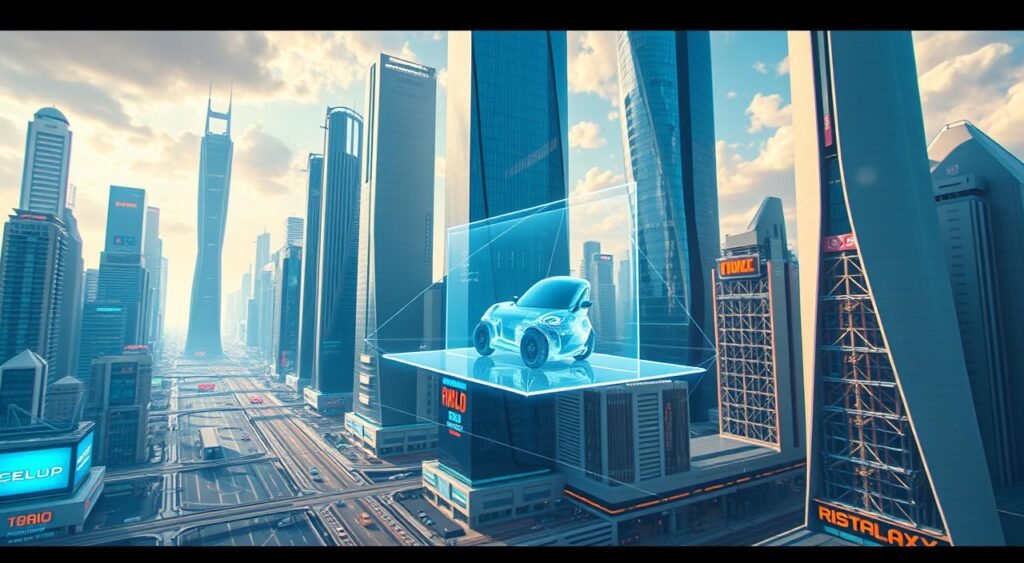All about Augmented Reality: World Changing Technology

Have you ever wondered how technology can transform your interaction with real world?
A augmented reality is revolutionizing the way we live and interact with the environment around us, bringing a new dimension to everyday life.
Exploring the augmented realityYou'll discover how it allows you to superimpose virtual elements on the real world, creating interactive and immersive experiences.
This article will guide you through the basic concepts and advanced applications of this technologyIt shows how it is becoming more and more present in our daily lives.
All About Augmented Reality: What It Is and How It Works
You may have heard of augmented reality, but you may not know exactly what it is or how it works. A augmented reality (AR) is a technology that combines virtual elements with the real world, enriching the user experience.
In this section, we'll explore the basic concepts of AR and how it differs from virtual reality.
Definition and Basic Concepts
A augmented reality is a technology that superimposes virtual information on the real world. This is done using devices such as smartphones, tablets and AR glasses.
AR can include anything from simple textual information to complex 3D models, enriching the user's interaction with the environment.
AR uses the device's camera to capture the real environment and then superimposes virtual information on this image. This creates an interactive and immersive experience for the user.
Differences between Augmented Reality and Virtual Reality
Although both technologies are immersive, the augmented reality and virtual reality have different objectives. AR adds virtual elements to the real world, while VR creates a completely virtual environment.
- AR maintains the connection with the real world, enriching it with virtual information.
- VR transports the user into a digital world, isolating them from the physical environment.
| Features | Augmented Reality | Virtual Reality |
|---|---|---|
| Environment | Real world with virtual elements | Completely virtual environment |
| Devices | Smartphones, tablets, AR glasses | VR glasses or headsets |
| Experience | Enriched interaction with the real world | Immersion in a digital world |

In short, the augmented reality is a technology that enriches the real world with virtual elements. virtual realitywhich creates completely digital environments. AR has the potential to transform many areas, from education to entertainment.
The Historical Evolution of Augmented Reality
The evolution of augmented reality is a story of continuous innovation and technological advances. From the first experiments to the present day, the augmented reality has come a long way, significantly transforming how we interact with the world around us.
First Experiments and Concepts
The first steps in augmented reality were developed in the final decades of the 20th century. In 1992, Louis Rosenberg developed one of the first functional AR systems, known as "Virtual Fixtures," designed to improve human performance in manual tasks.
The following year, Steven Feiner, Blair MacIntyre, and Doree Seligmann presented the KARMA prototype, demonstrating how AR could help with maintenance tasks.
Important milestones in the development of AR
Over the years, several important milestones have contributed to the development of augmented reality.
In 1999, Hirokazu Kato created ARToolKit, a library of software which facilitated the development of AR applications. The integration of ARToolKit into Adobe Flash in 2009 made AR accessible to millions of web users.
The launch of Pokémon GO in 2016 was a significant milestone, introducing AR to hundreds of millions of people and generating billions in revenue.
As one expert points out, "Augmented reality is revolutionizing the way we experience the world."
"AR technology has the potential to transform many industries, from education to entertainment."
With the continuous evolution oftechnologyof AR, we can expect to see moreapplicationsinnovative in the comingyears.

How Augmented Reality Technology Works
Have you ever wondered how augmented reality manages to blend the real world with virtual elements? The technology behind AR is fascinating and involves several components working in harmony to create an immersive experience for users.
Essential components for AR
A augmented reality depends on a few essential elements to work properly. Firstly, you need a device equipped with a camera, such as smartphones or tablets.
In addition, the device must have a processor capable of handling complex calculations in real time.
Another crucial component is the software or application RA, which processes the images captured by the camera and overlays the digital information.

Real-Time Data and Image Processing
O real-time data and image processing is what makes augmented reality truly interactive.
When you move your deviceThe system needs to instantly recalculate the position of the virtual elements to keep them aligned with the real world.
This involves several steps: capturing imagesThis involves analyzing the scene, detecting surfaces or markers, calculating the correct perspective and rendering the virtual elements.
Computer vision algorithms continuously analyze the flow of images to identify reference points that serve as anchors for the virtual elements.
A augmented reality is revolutionizing the way we interact with the world, creating personalized and interactive experiences for people. users.
With the ability to process data e images in real timeAR opens up new possibilities for various industries, from education to entertainment.
Aimed at the reader who wants to have their first contact with or expand their knowledge about the use of Virtual Reality (VR) and Augmented Reality (AR), this book presents a range of information about these technologies, which are considered important tools for the fields of medicine, education, architecture, engineering, among others. Divided into four chapters, the book presents the functional principles of VR and AR, their applications and their benefits. Using accessible and didactic language, it shows how these technologies can be used as auxiliary tools in our professional tasks, as well as in the teaching/learning process in various fields of science. Three important platforms for projects are also highlighted.
Types of Augmented Reality
You can experience augmented reality in various ways, depending on the type of technology used. Augmented reality diversifies into different categories, each offering unique experiences.
Marker-based Augmented Reality
Marker-based augmented reality uses specific images or objects to trigger the display of virtual content. When a device equipped with a camera captures the marker, the AR software superimposes digital information on the marker in real time.
Location-Based Augmented Reality
Location-based AR uses GPS, compass and accelerometer data to provide augmented reality experiences linked to specific locations. This allows users to see virtual information superimposed on the environment around them.
Superimposed Augmented Reality
Superimposed augmented reality displays virtual content directly on the user's vision, using devices such as AR glasses.
This allows you to see the real world with additional layers of information and virtual content superimposed.
For example, decorating apps allow you to visualize how a piece of furniture would look in your home, visually replacing the empty space.
Virtual make-up apps also use this technique, superimposing different cosmetic products on your face in real time.
Devices and Hardware for Augmented Reality
You can access augmented reality via various devices and hardware designed for this purpose. A augmented reality is becoming more and more present in our daily lives.
Smartphones and Tablets
Currently, smartphones e tablets are the most common devices for experimenting with augmented reality. Many AR applications are developed to work on these devices, using their cameras and sensors.
AR glasses and headsets
The AR glasses and headsets offer a more immersive experience. They are equipped with cutting-edge technology, such as high-resolution displays and motion sensors, providing a more natural interaction with the augmented reality.
Future Technologies: Contact Lenses and Implants
The future of augmented reality points to technologies that are even more integrated with the human body, such as smart contact lenses and even neural implants.
Companies and researchers are developing contact lenses with built-in microdisplays that could project information directly onto your retina. To find out more about other related technologies, visit this article.
Augmented Reality Applications in Education
With augmented reality, learning becomes a more engaging experience. You can explore content in an interactive way, making education more accessible and interesting.
Transforming Learning with Immersive Experiences
Augmented reality is being adopted in many educational institutions to create immersive learning experiences.
AR applications allow students to visualize complex concepts in an interactive way, increasing understanding and engagement.
For example, the Elements4D app has transformed chemistry teaching in secondary schools, allowing students to visualize chemical reactions in real time through physical blocks which, when viewed through the app, show chemical elements interacting.
This interactive experience facilitates the understanding of abstract concepts.
Success stories in educational institutions
Several institutions around the world are implementing augmented reality in innovative ways.
Medical universities are using AR applications to allow students to students practice surgical procedures on virtual patients before performing real operations.
NASA has developed an AR experience called Spacecraft3D, which allows students to explore detailed models of space probes and rovers, increasing interest in space science.
In addition, educational museums are implementing AR tours that bring exhibits to life, such as at the American Museum of Natural History, where dinosaurs can be seen life-size and in motion.
These augmented reality applications are changing the way knowledge is acquired, making learning more dynamic and attractive.
Augmented Reality in Industry and Business
Augmented reality is revolutionizing the way companies operate and interact with customers. With the ability to superimpose digital information on the real world, AR is transforming sectors such as retail, manufacturing and marketing.
Industrial Training and Maintenance
AR is being used to improve efficiency in industrial training and maintenance. Technicians can use AR glasses to receive step-by-step instructions on how to carry out complex repairs, reducing errors and increasing productivity.
Product Design and Prototyping
In product design, AR allows engineers and designers to visualize and interact with virtual prototypes, speeding up the development process and reducing costs. This makes it easier to identify potential problems before production.
Marketing and Consumer Experiences
AR is transforming marketing by allowing consumers to interact with products virtually before buying them.
Brands such as IKEA and Sephora are using AR applications to improve the customer experience, increasing satisfaction and reducing returns.
With the increasing adoption of AR, companies can expect a significant improvement in operational efficiency and customer satisfaction. The technology offers a wide range of possibilities for innovation and growth.
AR in Medicine and Health
Augmented reality is revolutionizing medicine, offering new forms of training and treatment.
With the ability to superimpose digital information on the real world, AR is transforming the way healthcare professionals learn and perform medical procedures.
Medical Training and Simulations
A augmented reality is transforming medical training by allowing students and residents to practice procedures on virtual patients before seeing real people.
Anatomical models in AR allow medical students to "dissect" virtual bodies, exploring layers of muscles, organs and circulatory systems in an interactive way.
- AR simulations of medical emergencies create realistic scenarios where professionals can practice care protocols in high-stress situations without real risks.
- The technology allows instructors to create personalized scenarios to train specific skills, with immediate feedback on student performance.
- Teaching hospitals are implementing AR training environments where multiple students can view and interact with the same virtual patient simultaneously, facilitating collaborative learning.
Augmented Reality Assisted Surgeries
A augmented reality is also being used to assist surgeons during complex procedures.
By superimposing digital images on the patient's body, surgeons can access vital information in real time, improving the precision and results of surgeries.
For more information on the use of AR in medicine, you can consult the article available at https://sol.sbc.org.br/index.php/enucompi/article/download/20465/20293/.
Games and Entertainment with Augmented Reality
Augmented reality is opening up new possibilities for entertainment and the games. With the ability to superimpose virtual elements onto the real world, AR is revolutionizing the way we interact with games and other forms of entertainment.
Pokémon GO and Other Popular Games
The success of games like Pokémon GO demonstrated the potential of augmented reality to create immersive and interactive gaming experiences. Other popular games are also incorporating AR to offer unique experiences to players.
The Future of Immersive Entertainment
The future of entertainment with augmented reality promises increasingly immersive experiences, where the line between the real and the virtual will become even more blurred.
Theme parks are already incorporating AR into their attractions, allowing visitors to interact with virtual characters and fantastic elements superimposed on the physical environment.
In addition, concerts and live events are experimenting with AR to create spectacular visual effects that can be viewed through smartphones or special glasses.
Interactive cinema with AR will allow viewers to see elements of the narrative unfolding around them, possibly from different perspectives depending on where they are sitting.
Physical board games are gaining digital layers through AR, where physical pieces come to life and interact with virtual elements, creating innovative hybrid experiences.
Augmented Reality apps to try out
Augmented reality is becoming more and more present in our lives through innovative applications. You can experience AR in a variety of ways, from navigation to interior decoration.
Google Maps Live View
Google Maps Live View is an example of how AR can be used for navigation. It provides real-time directions by overlaying information on the view from your camera. smartphone.
Apps for Decoration and Design
There are several apps that allow you to visualize how furniture and decorative objects will look in your home before you buy them. This makes decorating easier and more fun.
AR tools for everyday life
AR is also being used in practical everyday tools. Applications such as Measure (from Apple) and AR Ruler allow you to measure objects and distances using just your smartphone's camera.
In addition, Google Lens identifies objects, plants, animals and texts, providing relevant information instantly.
Other examples include Ink Hunter, which lets you visualize how a tattoo would look on your body before you get it, and SkyView, which uses AR to identify stars, planets and constellations when you point your smartphone at the sky.

Challenges and Limitations of AR Technology
Although AR offers innovative experiences, there are technological and ethical limitations to overcome. As you explore the world of augmented reality, it's important to understand the obstacles this technology faces.
Current Technological Barriers
AR technology still faces significant challenges in terms of processing data and images in real time. Devices need to be able to constantly scan and analyze their surroundings, which can be a challenge.
Technical limitations include the need to improve accuracy and processing speed, as well as reducing energy consumption and improving the quality of the user experience.
Privacy and ethics issues
AR raises important privacy and ethical issues. For example, AR applications can inadvertently capture sensitive information or people who have not consented to being recorded.
- The collection and storage of detailed spatial data from homes and private spaces raises concerns about digital security.
- The overlapping of digital content in the real world can create intellectual property and copyright problems.
It is essential to address these issues to ensure that AR technology is developed and used responsibly.
- Futuristic gun: This toy has a bold, futuristic design with aerodynamic lines
- Sturdy construction: Made from durable materials, this pistol is designed to withstand intense use during...
- Easy to handle: The ergonomic design and the right size allow children and adults to easily hold...
Conclusion
Augmented reality is not just an emerging technology, but a tool that is already transforming the world.
Throughout this article, we've explored how AR differs from virtual reality by enriching our perception of the world. real worldinstead of replacing it completely.
A augmented reality represents one of the most fascinating technological developments of our time, fundamentally transforming the world. shape how we interact with the world around us.
We have seen how this technology has evolved from experimental concepts to practical applications in various sectors, from education and medicine to industry and entertainment.
Advances in technology and hardware continue to expand the possibilities and accessibility of augmented reality to an ever-growing audience. In future In the near future, we can expect AR to become more and more integrated into our daily lives, with more natural interfaces and experiences more immersive.
As the boundaries between the digital and the physical continue to dissolve, the augmented reality invites us to reimagine not only how we use the technologybut how we perceive and interact with the world itself.
This makes it possible to deliver new experiences and sensations for the user, as well as being able to change the dynamics of how we know and interact with the world around us.
FAQ
Q: What is Augmented Reality?
A: Augmented Reality (AR) is a technology that combines elements of the real world with virtual information, improving the user experience.
Q: What are the main types of Augmented Reality?
A: There are several types of AR, including marker-based AR, location-based AR and overlay AR, each with its own characteristics and applications.
Q: Which devices support Augmented Reality?
A: You can experience AR on smartphones, tablets, glasses and specific headsets, which offer different levels of immersion and interactivity.
Q: How is Augmented Reality used in education?
A: AR is revolutionizing education by creating immersive and interactive learning experiences, making the teaching process more engaging and effective.
Q: What are the main applications of Augmented Reality in industry?
A: AR is used in industry for training, maintenance, product design and prototyping, improving efficiency and reducing costs.
Q: Can Augmented Reality be used for entertainment?
A: Yes, AR is widely used in games and entertainment, offering immersive and interactive experiences, as seen in popular games like Pokémon GO.
Q: What are the challenges of Augmented Reality technology?
A: AR faces challenges such as technological barriers, privacy issues and ethics, which need to be overcome for its continued development.
Q: How can Augmented Reality improve medicine?
A: AR can be used in assisted surgery, medical training and simulations, improving accuracy and safety in medical procedures.









